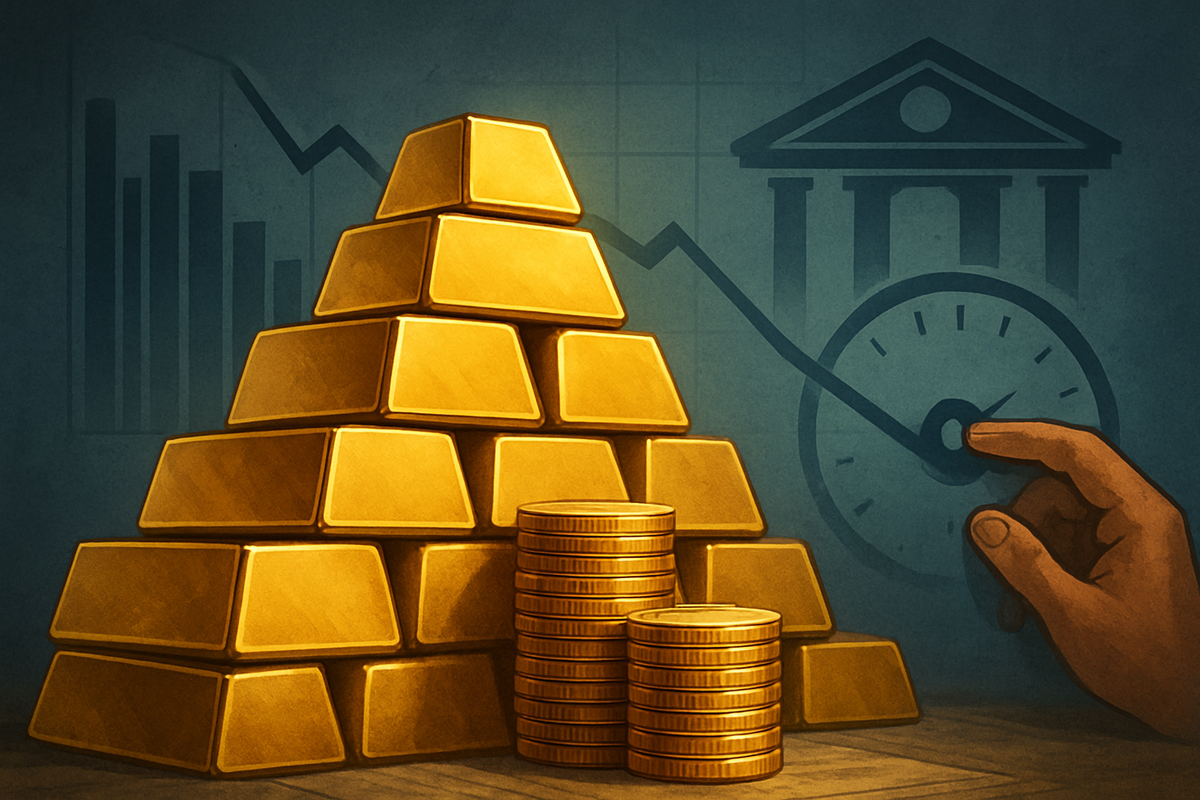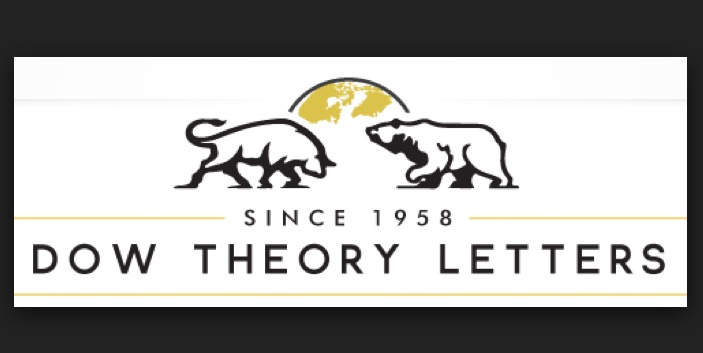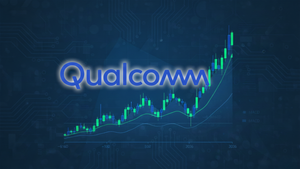
Gold prices have recently surged to multi-week highs, breaking past the $4,130 per ounce mark, driven by increasing market expectations of an imminent Federal Reserve interest rate cut. This bullish sentiment for the precious metal is primarily fueled by a series of recent weak economic data from the United States, signaling a cooling economy and intensifying calls for the Fed to ease its monetary policy. The immediate implication for the market is a heightened interest in non-yielding assets like gold, as the opportunity cost of holding them diminishes, and a potential weakening of the U.S. dollar, further boosting gold's appeal to international buyers.
Detailed Coverage: Economic Headwinds and the Fed's Dilemma
The current market sentiment, characterized by expectations of Fed rate cuts and rising gold prices, has developed through a series of economic indicators pointing to a decelerating U.S. economy. Key data points that have significantly influenced Federal Reserve rate cut expectations include a weakening labor market and subdued consumer confidence.
October 2025 saw notable job losses, particularly in government offices and retail sectors, marking what some reports suggest are the worst layoffs in approximately two decades. The Automatic Data Processing (ADP) National Employment Report for October indicated a meager increase of just 42,000 private sector jobs, significantly below expectations. Revisions to earlier nonfarm payroll data showed downward adjustments, and the unemployment rate ticked up to 4.1%. Major corporate layoffs, such as Amazon's (NASDAQ: AMZN) 14,000 corporate employees and UPS's (NYSE: UPS) anticipated 48,000 job cuts by year-end, have further heightened concerns about elevated unemployment. Simultaneously, the University of Michigan's consumer sentiment index for November fell to 50.3, its lowest level in three and a half years, reflecting mounting concerns among consumers about financial conditions and economic stability. These accumulating signs of economic deceleration have profoundly influenced the Federal Reserve's stance, leading to increased market expectations for a more accommodative monetary policy.
The timeline of events leading to this moment reveals a shift in the Fed's approach. After aggressively raising interest rates from March 2022 to July 2023 to combat soaring inflation, the Fed began to cut rates in response to a slowing global economy. A September 2024 rate cut was followed by gold surging to $2,789 per ounce. Gold then reached unprecedented highs above $3,500 per ounce by April 2025, partly supported by consistent central bank gold purchases. Further rate cuts occurred in September and October 2025, bringing the federal funds rate to a target range of 3.75%-4.00%. The recent weak economic data in late October and early November 2025 has intensified bets on further cuts, with gold prices surging to a two-week high on November 10, 2025, and breaking past $4,130 per ounce on November 11, 2025. Traders are now aggressively pricing in a high probability (around 60-67% according to the CME FedWatch Tool) of a Federal Reserve rate cut in December, with projections for a January 2026 cut climbing even higher to approximately 80%.
Key players and stakeholders in these monetary policy decisions include the Federal Reserve itself, particularly the Federal Open Market Committee (FOMC), which sets the federal funds rate. Fed Chair Jerome Powell's statements provide crucial forward guidance, though he has cautioned that a December rate cut is "not a foregone conclusion" due to data uncertainty caused by a prolonged government shutdown. Other FOMC members, such as Fed Governor Stephen Miran, have advocated for larger rate reductions, while some, like Kansas City Fed President Schmid, have dissented in favor of holding rates steady. Global central banks, notably China, have also been consistent net buyers of gold, diversifying their reserves and providing a fundamental floor to prices. Investors, both institutional and individual, play a significant role by reacting to economic data and Fed announcements, often flocking to gold-backed Exchange Traded Funds (ETFs) and physical gold as a traditional safe haven. The Fed's monetary policy impacts gold prices primarily through the opportunity cost of holding gold, the strength of the U.S. dollar, and safe-haven demand during economic uncertainty.
Initial market reactions have been pronounced. Gold prices surged to multi-week highs, and a broader rally across the precious metals complex, including silver, platinum, and palladium, has been observed. The U.S. dollar index experienced a notable slip, making gold more attractive to international buyers. Furthermore, there has been increased demand for gold-backed ETFs, underscoring gold's enduring appeal as a store of value against economic headwinds.
Corporate Impact: Winners and Losers in a Dovish Environment
The intensified bets on Federal Reserve rate cuts and the resulting rise in gold prices are poised to significantly impact gold mining companies and related industries, creating a landscape of potential winners and losers based on their operational efficiencies, financial health, and strategic positioning.
Gold mining companies are generally significant beneficiaries of rising gold prices. Higher gold prices directly translate into increased revenues and expanded profit margins for miners, as their selling price per ounce rises while production costs, though also subject to inflation, may grow at a slower rate. This leads to higher cash flows and earnings. Companies best positioned to win from this environment typically share characteristics such as low production costs, strong balance sheets, efficient operations, and strategic growth initiatives. For instance, Newmont (NYSE: NEM), the world's largest gold producer, is considered a "blue-chip" in the sector due to its strong balance sheet and low-cost production. Similarly, Barrick Gold (NYSE: GOLD) has seen its stock surge, benefiting from higher gold prices and announcing significant share buyback programs. Canadian mining giant Agnico Eagle Mines (NYSE: AEM), known for its low-cost mines in stable jurisdictions, and AngloGold Ashanti (NYSE: AU), which has reported its strongest balance sheet in over a decade, are also well-positioned. Mid-tier producers like Kinross Gold (NYSE: KGC) and Alamos Gold (NYSE: AGI), operating at competitive all-in sustaining costs, also stand to benefit. Beyond direct miners, gold streaming and royalty companies such as Franco-Nevada (NYSE: FNV) and Royal Gold (NASDAQ: RGLD) offer a less risky exposure to rising gold prices, benefiting from consistent cash flows without direct mining operational costs.
Rising gold prices incentivize mining companies to boost exploration budgets and invest more in new projects, making previously uneconomical deposits viable. Strong cash flows also enable them to strengthen balance sheets, reduce debt, and return capital to shareholders through increased dividends or share buyback programs. Lower interest rates further reduce borrowing costs for highly leveraged companies.
Conversely, some companies might not benefit as much or could even face challenges. High-cost producers, for example, will see thinner profit margins even with rising gold prices, making them less competitive. Companies that have locked in lower future selling prices through unfavorable hedging contracts might miss out on the full upside of surging spot gold prices. Furthermore, companies facing significant operational inefficiencies, project delays, high capital expenditure commitments, or operating in politically unstable regions may struggle to fully capitalize on a high gold price environment.
Precious metal ETFs also stand to gain significantly. Funds that hold physical gold, such as SPDR Gold Shares (NYSEARCA: GLD) and iShares Gold Trust (NYSEARCA: IAU), directly track the price of gold, increasing in value proportionally. Gold mining ETFs, like VanEck Gold Miners ETF (NYSEARCA: GDX) and VanEck Junior Gold Miners ETF (NYSEARCA: GDXJ), offer diversified exposure to a basket of mining companies and can provide leveraged returns to the underlying gold price due to the operational leverage of the miners themselves. These ETFs are attractive during periods of market volatility and economic uncertainty, acting as a safe haven and offering diversification benefits.
Wider Significance: A Broader Shift in the Financial Landscape
The intensified bets on Federal Reserve rate cuts and the subsequent rise in gold prices are significant trends reflecting broader shifts in the precious metals market and the global financial landscape. These developments are influenced by economic uncertainty, the search for safe-haven assets, and the unique characteristics of gold and other precious metals in a changing monetary policy environment.
Beyond gold, the entire precious metals market, encompassing silver, platinum, and palladium, is experiencing an upturn. This is driven by similar safe-haven demands, as well as increasing industrial applications, particularly in green technologies. The broader precious metals market is projected to grow substantially from an estimated value of $327.47 billion in 2025 to $533.12 billion by 2032. Central banks worldwide are also contributing to this trend by accumulating gold reserves as a strategic asset and a hedge against geopolitical instability and currency devaluation, providing a robust underlying support for prices. This "de-dollarization" trend, where central banks diversify away from the U.S. dollar, is a significant long-term driver for gold demand.
In the broader financial markets, Fed rate cuts are generally intended to stimulate economic activity. Lower borrowing costs encourage consumer spending and business investment, which can lead to increased corporate profits and potentially higher stock prices. However, if rate cuts signal an impending recession, stock markets might initially decline. A unique aspect of the current environment is the coexistence of record-high stock markets and gold prices, indicating investor optimism for growth alongside a persistent demand for safe-haven assets due to economic stress and policy uncertainty. Prolonged periods of low interest rates can also raise concerns about asset bubbles and excessive risk-taking.
A potential Fed rate cut carries several regulatory and policy implications. Rate cuts typically lead to a weaker U.S. dollar, which can benefit emerging market economies by reducing the burden of servicing dollar-denominated debt and making their exports more competitive. Financial institutions, faced with lower yields on traditional fixed-income assets, might increase their allocation to riskier assets, potentially leading to higher portfolio volatility. Regulators may need to monitor for signs of asset bubbles or excessive risk-taking in an extended low-interest-rate environment, potentially focusing on investor protection and transparency in alternative investment products.
Historically, gold has demonstrated a consistent positive reaction to Federal Reserve interest rate cutting cycles, though the magnitude can vary with the economic context. Gold prices have seen significant increases in the 24 months following the initial rate cut in previous easing cycles: a 31% rise after the November 2000 cut, a 39% increase after the June 2007 cut, and a 26% gain following the June 2019 cut. Gold tends to perform particularly well when rate cuts are enacted in response to economic slowdowns, financial crises, or inflation concerns, as investors seek safe-haven assets. The 2008 financial crisis, for example, saw gold propelled to all-time highs following near-zero interest rates. While gold often rallies on the day of a rate cut, it can experience short-term struggles around the one-month mark, but returns are overwhelmingly positive over the 6-12 month horizon. The current scenario echoes these historical periods where Fed policy provided a strong tailwind for gold, reinforcing its role as a crucial safe-haven asset.
What Comes Next: Navigating a Shifting Landscape
The Federal Reserve's anticipated interest rate cuts are poised to significantly influence gold prices and the broader market, presenting both opportunities and challenges for investors and companies in the short and long term. Current market expectations lean towards a period of monetary easing, with a 60-70% probability of a December rate cut, followed by further reductions into 2026.
In the short term, gold prices are expected to maintain an upward momentum, largely driven by the prospects of Fed rate cuts and ongoing safe-haven demand amidst global uncertainties. Analysts project gold to average around $4,000/oz in the current quarter and potentially reach $4,100/oz in Q1 2026. The long-term outlook for gold remains robust and bullish. Major financial institutions project gold prices could top $5,000 by 2026, potentially reaching $5,200-$5,300, representing a significant increase from current levels. This optimistic forecast is underpinned by lower opportunity costs, a weakening U.S. dollar, persistent safe-haven demand due to economic and geopolitical uncertainties, and strategic central bank accumulation.
A Federal Reserve rate-cutting cycle typically signals a shift towards economic easing, which has profound and complex effects across various asset classes. Equity markets generally respond positively to Fed rate cuts, as lower borrowing costs support corporate earnings and improve valuation models. Growth stocks, particularly within technology sectors, often outperform, as do small-cap companies which are more reliant on debt financing. Fixed income markets will likely see Treasury yields fall, boosting the price of existing bonds. In currency markets, Fed rate cuts typically weaken the U.S. dollar, which can benefit emerging market economies.
For investors, strategic pivots include reevaluating fixed income duration, assessing equity exposure (especially in rate-sensitive sectors like technology and real estate), and diversifying portfolios with assets that benefit from lower rates and those that provide protection against associated risks, such as gold. Investors may also need to shift from cash and short-term instruments as yields decline. For companies, this environment presents opportunities to optimize financing with lower borrowing costs, pursue strategic investments, and potentially see increased M&A and IPO activity. However, challenges include potential market volatility if rate cuts signal a deeper downturn, inflation concerns if aggressive easing reignites price pressures, and the risk that rate cuts might not effectively transmit to market-based rates.
Potential scenarios for Fed policy and gold's performance include a "controlled easing" (soft landing) where the Fed executes measured rate cuts, leading to positive gold performance. An "aggressive easing" scenario, in response to a significant economic downturn, would likely see gold experience a significant surge as investors flock to safe havens. Conversely, a "hawkish pivot" or "slower easing" due to persistent inflation or stronger-than-expected economic growth could stall or correct gold's momentum. Finally, "policy uncertainty and dysfunction," perhaps due to divergent views among Fed officials or data blackouts, would likely benefit gold as a safe haven.
Comprehensive Wrap-up: A Bullish Horizon for Gold
In summary, the recent surge in gold prices is a direct consequence of intensifying expectations for Federal Reserve interest rate cuts, driven by a series of weak U.S. economic data points, particularly in the labor market and consumer confidence. This environment reduces the opportunity cost of holding non-yielding assets like gold and is likely to lead to a weaker U.S. dollar, further bolstering gold's appeal. The market assessment moving forward points to a robust and sustained bullish outlook for gold, underpinned by dovish Fed policy, persistent economic uncertainty, strong central bank demand, and ongoing geopolitical tensions. This confluence of factors suggests a potential structural shift in gold's role as a strategic asset.
The significance and lasting impact of these trends are profound. Gold is not merely reacting to short-term market fluctuations but is benefiting from fundamental shifts in monetary policy and global economic dynamics. The historical precedent of gold performing strongly during Fed easing cycles, especially when accompanied by economic slowdowns, reinforces this outlook.
Investors should closely monitor several key watch points in the coming months. Foremost are economic data releases, particularly labor market stability (unemployment rates, payrolls), inflation trajectory (CPI, PCE), and consumer spending and confidence. Any signs of continued economic weakness will reinforce the case for Fed rate cuts. Secondly, Federal Reserve communications will be critical. Statements and speeches from Fed officials, especially Chair Jerome Powell, should be carefully analyzed for forward guidance on monetary policy. The CME FedWatch Tool provides a real-time gauge of market expectations. Finally, geopolitical events must be watched closely. Any escalation of global tensions, conflicts, or trade disputes will continue to fuel safe-haven demand for gold. By carefully monitoring these indicators, investors can better position their portfolios to capitalize on the evolving dynamics of the gold market. The current environment, marked by dovish Fed expectations and persistent global uncertainties, suggests a sustained bullish outlook for gold.
This content is intended for informational purposes only and is not financial advice






